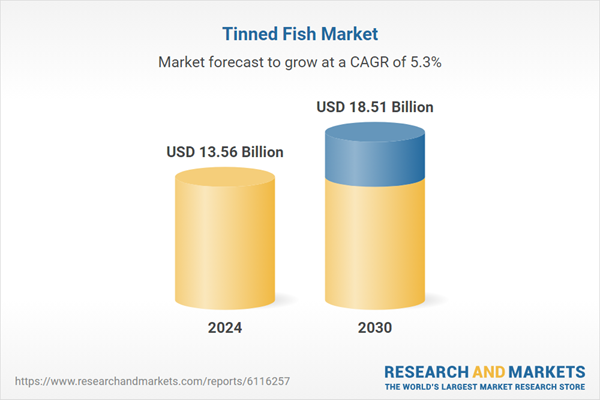Speak directly to the analyst to clarify any post sales queries you may have.
10% Free customizationThis report comes with 10% free customization, enabling you to add data that meets your specific business needs.
Key Market Drivers
Rising Demand for Convenient and Ready-to-Eat Protein Sources
The modern consumer lifestyle, shaped by fast-paced urban living, long working hours, and reduced time for cooking, has fueled the demand for convenient and ready-to-eat food options. Tinned fish fits perfectly into this narrative, offering a hassle-free, protein-rich, and shelf-stable food source that requires no refrigeration or elaborate preparation. Consumers across various age groups - especially millennials and working professionals - are increasingly turning to canned tuna, sardines, salmon, and mackerel as quick meal components or snacks. NOAA Fisheries reports that the U.S. produces approximately USD 11 billion worth of processed seafood annually, with exports accounting for nearly half that value.Unlike perishable seafood, tinned fish provides both portability and longevity, making it ideal for travel, emergencies, or daily consumption. Moreover, the high protein and omega-3 fatty acid content in fish appeals to health-conscious individuals looking to maintain a nutritious diet with minimal effort. This trend is not just limited to developed regions; even in emerging economies, where rising disposable incomes and changing dietary habits are altering food preferences, canned seafood is gaining popularity. The convenience factor, coupled with the health appeal, is pushing manufacturers to innovate with new flavors, packaging formats, and recipe integrations, further strengthening the market’s position globally.
Key Market Challenges
Consumer Perception and Preference for Fresh and Frozen Alternatives
One of the most significant challenges facing the global tinned fish market is the persistent consumer perception that fresh or frozen fish is superior in quality and taste. In many regions, especially in Asia and parts of Europe, fresh seafood is deeply embedded in culinary traditions and cultural preferences. Consumers often associate tinned fish with inferior taste, high sodium content, and lack of freshness, even though technological advancements have significantly improved the nutritional preservation and flavor retention in canned products.This perception is particularly strong among younger, urban consumers who are increasingly drawn to gourmet, freshly-prepared meals and who associate tinned foods with wartime rations or economic constraints. Moreover, high-end restaurants and culinary influencers tend to favor fresh seafood, which reinforces these biases. As a result, canned seafood is often perceived as a budget product, limiting its appeal among premium consumers. While the growing demand for convenience has helped shift some opinions, altering long-standing beliefs about product quality remains a critical hurdle. Overcoming this challenge requires strong marketing, consumer education, and continued product innovation to demonstrate that tinned fish can be both high-quality and gastronomically appealing.
Key Market Trends
Premiumization and Gourmet Positioning of Canned Seafood
A key trend transforming the global tinned fish market is the growing shift toward premiumization and gourmet positioning. Traditionally viewed as a utilitarian food product, canned fish is increasingly being rebranded as a high-quality, artisanal item. Consumers - especially millennials and Gen Z - are seeking more than just convenience; they want culinary experience, storytelling, and transparency in their food. In response, producers are launching upscale tinned fish lines featuring rare or sustainably caught species, innovative marinades (such as lemon-thyme or chili-garlic), and high-end oils like extra virgin olive oil.Packaging has also evolved to reflect this shift, with stylish tins, artisanal labels, and eco-conscious materials appealing to aesthetic and ethical sensibilities. Companies from Europe, especially Spain, Portugal, and France, have been at the forefront of this movement, exporting gourmet canned seafood that blends traditional fishing heritage with modern gastronomy. Chefs and food influencers are further endorsing premium tinned fish as a central element in charcuterie boards, tapas, and fusion recipes. This trend not only enhances the perceived value of tinned fish but also opens new revenue streams in the luxury food segment, allowing brands to cater to discerning consumers willing to pay more for taste, origin, and authenticity.
Key Market Players
- Thai Union Group PLC
- Dongwon Industries / StarKist
- Bolton Group (Rio Mare)
- Bumble Bee Seafoods
- FCF Co. Ltd.
- Century Pacific Food Inc.
- Grupo Calvo
- Austevoll Seafood ASA
- High Liner Foods
- King Oscar AS
Report Scope:
In this report, the Global Tinned Fish Market has been segmented into the following categories, in addition to the industry trends which have also been detailed below:Tinned Fish Market, By Product Type:
- Tuna
- Mackerel
- Salmon
- Others
Tinned Fish Market, By Distribution Channel:
- Offline
- Online
Tinned Fish Market, By Region:
- North America
- United States
- Canada
- Mexico
- Europe
- France
- United Kingdom
- Italy
- Germany
- Spain
- Asia-Pacific
- China
- Japan
- India
- South Korea
- Vietnam
- South America
- Argentina
- Colombia
- Brazil
- Middle East & Africa
- South Africa
- Saudi Arabia
- UAE
- Turkey
Competitive Landscape
Company Profiles: Detailed analysis of the major companies present in the Global Tinned Fish Market.Available Customizations:
With the given market data, the publisher offers customizations according to a company's specific needs. The following customization options are available for the report.Company Information
- Detailed analysis and profiling of additional market players (up to five).
This product will be delivered within 1-3 business days.
Table of Contents
Companies Mentioned
- Thai Union Group PLC
- Dongwon Industries / StarKist
- Bolton Group (Rio Mare)
- Bumble Bee Seafoods
- FCF Co. Ltd.
- Century Pacific Food Inc.
- Grupo Calvo
- Austevoll Seafood ASA
- High Liner Foods
- King Oscar AS
Table Information
| Report Attribute | Details |
|---|---|
| No. of Pages | 184 |
| Published | August 2025 |
| Forecast Period | 2024 - 2030 |
| Estimated Market Value ( USD | $ 13.56 Billion |
| Forecasted Market Value ( USD | $ 18.51 Billion |
| Compound Annual Growth Rate | 5.3% |
| Regions Covered | Global |
| No. of Companies Mentioned | 10 |









